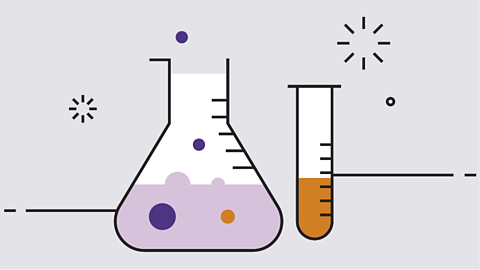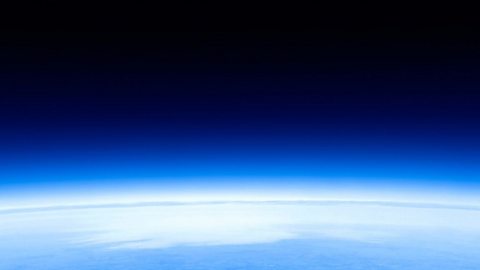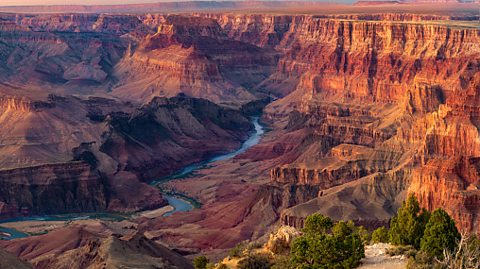Key points
- The atmosphere is a mixture of gases.
- The atmosphere is mostly nitrogen (approximately 80%) and oxygen (approximately 20%). The remaining gases are found in much smaller proportions, such as carbon dioxide and water vapour.
- Oxygen in the atmosphere is essential for all living things to stay alive, and for the combustion (burning) of fuels.
What do the following substances have in common?
Nitrogen, carbon dioxide, hydrogen, oxygen, hydrogen, helium.
They are all gases.
Three of them are found in the Earth’s atmosphere in noticeable amounts – read on to find out which ones.

Video
Watch the video to learn about the mixtureWhen two or more compounds or elements are present without being chemically bonded together. of gases in the atmosphereThe atmosphere is the layer of gases surrounding a planet..
The air - it’s not something we think about much, but we wouldn’t last very long without it!
Our planet is surrounded by an invisible shell of air, called the atmosphere, held in place by the Earth’s gravitational field. It’s made up of a mixture of different gases.
About 78% of the atmosphere is nitrogen gas, N2, which is unreactive and just sort of hangs around.
About 21% is oxygen, O2, and that’s the stuff we need to breathe in.
That leaves approximately 1%, which is made up of atoms of unreactive argon, and molecules of carbon dioxide.
Carbon dioxide is a product of respiration, but it’s also taken in by plants for photosynthesis.
And in fact, before plants appeared on Earth, scientists think there was much more carbon dioxide but no oxygen in the early atmosphere.
The composition of the atmosphere has changed over time, and is changing right now.
Because of human activities like farming and industry, we’re putting carbon dioxide back into the atmosphere more quickly than ever before.
I wonder what our atmosphere will look like in a million years?
Which two gases make up around 99% of the Earth's atmosphere?
Nitrogen and oxygen.
The atmosphere is made up of 78% nitrogen (Nâ‚‚) and 21% oxygen (Oâ‚‚).
Composition of the atmosphere
The Earth’s atmosphere is the relatively thin layer of gases surrounding the planet. The atmosphere is held close to Earth by gravity, but the higher you go away from the Earth’s surface, the thinner the air. Because of this, it’s impossible to say how high the atmosphere extends above Earth accurately. However, most scientists use around 100 km when describing where the atmosphere ends and space begins.
The three gases with the highest percentages in the atmosphere are all elements:
- 78% nitrogen, Nâ‚‚
- 21% oxygen, Oâ‚‚
- 0.9% argon, Ar
These three gases make up 99.9% of the atmosphere.
The remaining gases are found in much smaller proportions. These include carbon dioxide and water vapour.

Did you know?
Even though it is hard to imagine that gases have much mass, the atmosphere extends so far above us, that the weight of the air above you is what causes air pressure (atmospheric pressure).

This weight of the air above is equivalent to the weight from a 1 kg mass pressing down on every square centimetre of your skin! You don’t notice this pressure because it’s always been there and it is balanced by the pressure of the liquids inside your body.
Which gas makes up around 1% of the atmosphere?
Argon (Ar).
Living things and the atmosphere
All living things on Earth, including humans, use oxygen from the atmosphere for respirationThe chemical process that occurs inside the cells of most living things, when glucose reacts with oxygen to produce carbon dioxide and water. to stay alive.
Respiration is the chemical process that occurs inside cells to release energy from glucose when it reacts with oxygen.
The word equation is:
Glucose + oxygen → carbon dioxide + water

Plants and some bacteria use carbon dioxide from the atmosphere for photosynthesisA chemical process used by plants to make glucose and oxygen from carbon dioxide and water, using light energy. Oxygen is produced as a by-product of photosynthesis. Algae subsumed within plants and some bacteria are also photosynthetic..
Photosynthesis is the chemical process when carbon dioxide and water react together, in the presence of light and chlorophyllA green pigment which is found in plant cells and absorbs light to allow photosynthesis to take place., to produce glucose and oxygen.

The word equation is:
Carbon dioxide + water → glucose + oxygen
You can see from the equations that the reactantThe chemical present at the start of a reaction. Reactants appear on the left of a chemical equation, before the arrow →. in one process are the productA chemical which is made in a chemical reaction. Products are written on the right of a chemical equation, after the arrow (→). in the other process. Chemically speaking, these two processes are opposite.
Even plants and animals that live in the oceans use gases which have dissolved into the seawater from the air above it.
What is the name of the process that takes place inside the cells of living things and releases energy from glucose in the presence of oxygen from the atmosphere?
Respiration.
Combustion and the atmosphere
Combustion is another word for burning. Combustion happens when a fuelA substance which is burned to release energy. is heated and reacts with oxygen to release useful energy. Fuels are burned for lots of different purposes.
For example:
- Motor vehicles - the fuel is usually petrol or diesel
- In a domestic boiler for central heating and hot water - the fuel is usually natural gas (methane)
- For cooking - the fuel is often natural gas (methane)
- To keep warm - the fuel can be wood, coal or natural gas
For combustion to occur, there needs to be a fuel, heat and oxygen. This is represented by the fire triangle.
If one side of the fire triangle is removed, combustion cannot happen. In most situations, the oxygen for combustion comes from the atmosphere.
Most fuels contain carbon. When they are burned, carbon dioxide is produced. Human activities - like burning fossil fuelA fuel which was made millions of years ago from the remains of dead plants or animals. Examples include coal, natural gas and the fuels which we get from crude oil (eg petrol and diesel). - over the past 200 years have increased the amount of carbon dioxide in the atmosphere, thickening the earth’s layer of greenhouse gas Gases such as water vapour, carbon dioxide, and methane in the Earth’s atmosphere that trap heat.. As a result, the earth has been getting hotter. This is known as global warmingThe increase in Earth’s average temperature, caused mainly by the build-up of greenhouse gases in the atmosphere..
Which of the following is not a fuel?
Methane, carbon dioxide, wood, petrol.
Carbon dioxide is not a fuel. It is produced when many fuels burn.

Test your knowledge
Quiz
Play the Atomic Labs game! gamePlay the Atomic Labs game!
Try out practical experiments in this KS3 science game.

More on The Earth and atmosphere
Find out more by working through a topic
- count4 of 8

- count5 of 8

- count6 of 8

- count7 of 8
